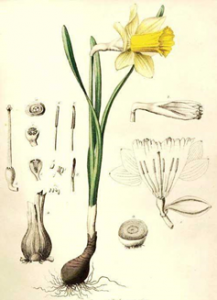Lesson Plans
Narcissus
Narciso
- Italy
- Water
- B1
Warming Up
- What do you see in the picture?
- Do you know the myth of Narcissus?
- What are your feelings when you look at this work of art?
- Did you know that Narcissus is a flower, too?

Vocabulary

Read the poem “Narcissus” by Federico Garcia Lorca (translated by Edwin Honig) and fill the table:
Narcissus.
Your perfume.
And the river bottom.
My desire is to stay
By your side
Flower of love,
Narcissus.
Over your unseeing eyes
Cross waves and sleeping fish.
Over mine
Birds and butterflies
Weave oriental patterns.
You so small and I, huge.
Flower of love.
Narcissus.
The frogs, how crafty they are.
Yet they do not leave undisturbed
The mirror that reflects
Your wild joy, and mine.
Narcissus.
My sorrow.
Oh, my very sorrow itself.
Cultural Heritage Background

The narcissus is a simple flower to grow, elegant and fragrant. It gracefully adorns the balconies of English houses because it can stand the cold.
There are over 50 species, but if we consider the hybrids made by growers, the number reaches the hundreds.
Do you know where the name of this flower comes from? It is from the Mediterranean area. It is assumed that its name derives from the Greek narkao, due to its perfume, which is inebriating like a narcotic.
The narcissus flower is related to the myth of the young man who loved his image mirrored in the water and died trying to reach it. The myth also warns, obliquely, of the high danger of narcissus leaves and bulbs. In fact, they contain an alkaloid, narcisin, which can cause death.
Listening
Watch this video (you can also activate subtitles) How to Plant Indoor Narcissi: Winter/Spring Garden Guide
In this video you can learn how to plant and grow daffodils indoors in pots.
Listening Comprehension
Reading the story
Narcissus was a beautiful and strong boy. He used to spend his days hunting and riding in the woods. One day he saw Echo, a mountain nymph. Echo fell in love with the young man and came out of her hiding place to declare her feelings to him. Narcissus, however, rejected her rudely: he was too beautiful to waste his time with a nymph.
From that day on, heartbroken, Echo continued to follow Narcissus wherever he went. The nymph was consumed by her love for Narcissus and by her pain at being rejected. Her body became transparent and she shut herself up in a cave in the heart of the mountain, singing for Narcissus. Thus, Echo vanished! Only a handful of bones and her voice remained. Echo’s voice is still there now, and responds to those who call out while crossing the mountains, in the hope that one day Narcissus will also respond. Over time, however, she has become increasingly weak and today she can only repeat the last syllables of the words of the travellers.
Narcissus, on the other hand, continued his life. The gods, after seeing how selfish and indifferent he was, decided to punish him. One day, Narcissus was hunting when he saw a crystalline little lake among the vegetation. The young man dismounted from his horse and went over to the lake. There he saw his face, reflected in the water: it was so beautiful that Narcissus fell in love with his reflected image. From that moment on, he went every morning to visit himself reflected in the little lake, convinced that he saw some deity of the waters. One day he stretched out over the water to caress that face and lost his balance, falling into the water. The lake closed over him and Narcissus never emerged again. On the shore sprouted a beautiful yellow flower, with an intense scent, which in memory of that selfish young man took the name of Narcissus.
The “Metamorphoses” is an epic-mythological poem by Publius Ovidius Naso (43 BC – 17 AD). This poem focused on the phenomenon of metamorphosis (the possibility of changing physical shape). The “Metamorphoses” was composed of fifteen books in which Ovid collected tales from Greek and Roman mythology, including the story of Echo and Narcissus.
Myths perhaps arose from the need to provide an answer to universal human questions, questions about the mysteries of the cosmos and of life. Myths often embody natural phenomena, tell of historical events, and describe states of mind in terms of concrete and palpable figures that mirror the human condition. Thanks to Ovid we know many of them, too.
Reading Comprehension
Additional activities
- If you want to know more about narcissism
Les stéréotypes des narcissiques | Psycho | ARTE – YouTube
- Can you think of other flowers related to myths?
Extra resources for learners
- The “Metamorphoses” of Ovid (book)
https://en.wikipedia.org/wiki/Metamorphoses
- “Narcissus” by Alanis Morissette (song)
